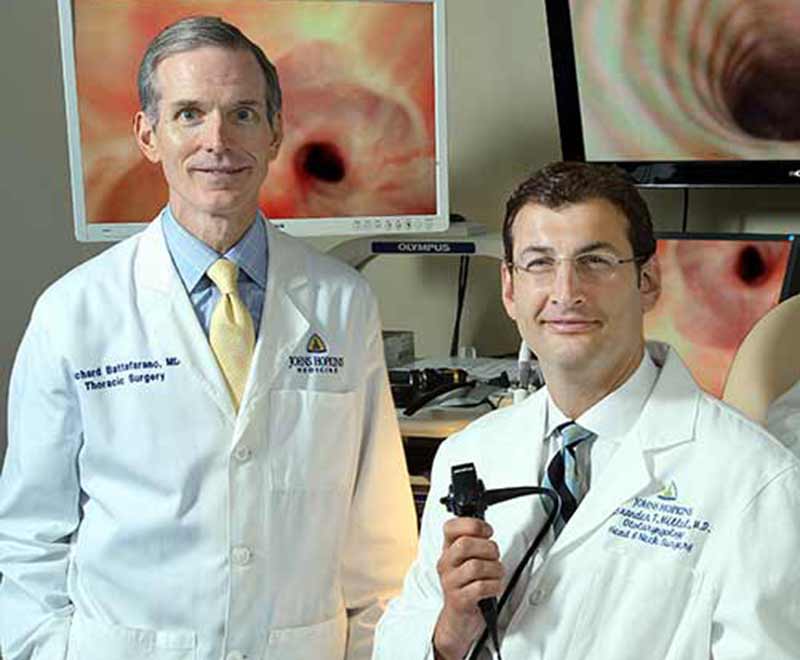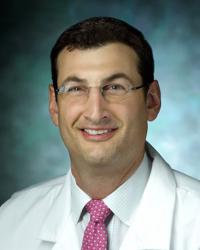-
Richard J. Battafarano, MD PhD

- Regional Director of General Thoracic Surgery
- Associate Professor of Surgery
The Johns Hopkins Complex Airway Clinic is a multidisciplinary program for adults experiencing airway disorders caused by prolonged intubation or tracheostomy.
Explore On This Page:
Schedule An Appointment
Schedule by phone
Baltimore: 443-997-6467 Bethesda: 301-896-3332
Schedule online through MyChart
Some services may not be available for online scheduling.
Log into MyChart
| Sign up for MyChart
Conditions We Treat
The Complex Airway Clinic provides multidisciplinary evaluation and treatment plans for many airway conditions, including:
Laryngotracheal Stenosis
Laryngotracheal stenosis is a condition characterized by a narrowing of the airway through the voice box (larynx) and the windpipe (trachea) within the neck. This condition makes breathing much more difficult because less air can pass through to reach the lungs. Laryngotracheal stenosis may be caused by a number of factors including swelling, medications, an obstructive growth or vocal chords that have become immobile. Patients experiencing this condition will often make a high-pitched noise when breathing called stridor.
Subglottic Stenosis
Subglottic stenosis is the narrowing of the airway just below the vocal cords (subglottis). Subglottic stenosis is rare and early signs of this condition may be misdiagnosed as asthma or bronchitis. Symptoms of subglottic stenosis include noisy or difficult breathing or the inability to breathe without a tracheostomy tube. Depending on the location of the narrowed airway, you may be diagnosed with glottic stenosis rather than subglottic stenosis which refers to narrowing at the vocal cords rather than just below them.
Glottic Stenosis
Narrowing at the level of the vocal cords is called glottic stenosis. It is a life-threatening condition in which the vocal cords cannot open due to the formation of scar tissue. This causes severe difficulty breathing and can often result in voice changes. Glottic stenosis is most frequently caused by breathing tubes that injure the mucosa and underlying cartilage behind the vocal cords. Other rarer causes include radiation injury, autoimmune disease, and burn/inhalation injury.
Treatment of Complex Airway Disorders – FAQs
Otolaryngologist Alexander Hillel, M.D., director of the Johns Hopkins Complex Airway Clinic, discusses complex airway disorders (layngotracheal stenosis), how to get a correct diagnosis and what treatment options are available depending on the severity of the disease.
Our Approach
Our approach to Laryngotracheal Stenosis
Following your diagnosis, the multidisciplinary team of the Complex Airway Clinic may discuss the following treatments with you:
- Endoscopic excision and dilation: the removal of tissue and opening of the airway without making any external incisions.
- Endoscopic placement of a tracheal stent: the placement of a stent in the windpipe (trachea) to hold the airway open.
- Cricotracheal/tracheal resection: removal of the damaged part of the windpipe (trachea).
- Endoscopic laryngotracheoplasty (Maddern procedure): reconstruction of the upper airway.
Our approach to Glottic Stenosis
We may discuss the following treatments for glottic stenosis (narrowing at the vocal cords) include:
- Laser cordotomy: laser incision made in paralyzed vocal cords to allow greater airflow.
- Partial arytenoidectomy: partial removal of the areytenoid cartilage located around the vocal cords.
- Open-airway surgery of the larynx, including posterior cricoid split with rib graft: surgical opening of the airway using a graft of rib cartilage to support the opening.
Meet Our Specialists
Our team of multidisciplinary experts specializes in the treatment of airway disorders.



